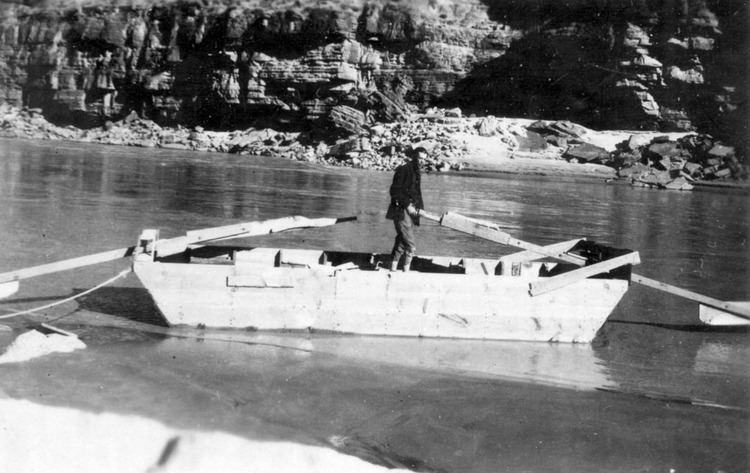Name Glen Bessie | ||
 | ||
Wandering leaves the story of glen and bessie hyde
Glen and Bessie Hyde were newlyweds who disappeared while attempting to run the rapids of the Colorado River through Grand Canyon, Arizona in 1928. Had they succeeded, Bessie Hyde would have been the first woman known to accomplish that feat.
Contents
- Wandering leaves the story of glen and bessie hyde
- Early life
- Colorado River trip
- Disappearance
- Search
- Theories
- References
Early life
Glen Rollin Hyde, born December 9, 1898, was a farmer from Twin Falls, Idaho; Bessie Louise Haley, born December 29, 1905, was a divorcee originally from Parkersburg, West Virginia. They met in 1927 on a passenger ship traveling to Los Angeles, California, and married April 10, 1928, the day after Bessie's divorce from her first husband was finalized.
Colorado River trip
Glen Hyde had some experience with river running, having traveled the Salmon and Snake Rivers in Idaho with "Cap" Guleke, an experienced river runner, in 1926. Bessie was more of a novice. In October 1928, the Hydes went to Green River, Utah, where Hyde built his own boat, a twenty-foot wooden sweep scow, the type used by river runners of that time in Idaho. The couple set off down the canyons of the Green and Colorado Rivers on October 20, 1928, as a honeymoon adventure trip. Glen wanted to set a new speed record for traveling through the Grand Canyon, while also putting Bessie in the record books as first documented woman to run the canyon.
Disappearance
They were last seen Sunday, November 18, 1928, when they boated away downriver below Hermit Rapid. The couple had hiked Bright Angel Trail out of the canyon to resupply a few days earlier. At the South Rim they approached photographer Emery Kolb at his studio and home on the canyon rim, where they were photographed before returning down into the canyon. Some Colorado River historians, such as Otis R. Marston note that Adolph G. Sutro rode from Phantom Ranch to Hermit Rapid with them in the scow.
Search
A search was launched by Glen's father Rollin even before the couple were to be considered overdue at Needles, California on December 6, 1928. On December 19, a search plane spotted their scow adrift around river mile 237; it was upright and fully intact, with the supplies still strapped in. A camera recovered from the boat by Emery and Ellsworth Kolb revealed the final photo to have been taken near river mile 165, probably on or about November 27. The search uncovered evidence to indicate the couple made it as far as river mile 226, Diamond Creek, where it is believed they made camp. Bessie noted in her journal that they had cleared 231 Mile Rapid. Historian Otis R. Marston made a compelling case that the couple were most likely swept out of the boat when their scow hit submerged rocks in the heavy rapids near river mile 232. In describing the rapid, Marston noted "...pieces of granite wall lie submerged where they have damaged, snared, or capsized more boats than any other location in the canyon." No trace of the Hydes has ever been found.
Note: the Sutro reference regarding riding with the Hydes for one day and possibly being the last to see them, is mentioned specifically in the Ken Burns PBS documentary series National Parks: America's Best Idea, and in Marston's book.
Theories
The romance of the story, coupled with the lack of any conclusive evidence as to the fate of the Hydes, has led to a number of legends and rumors. An elderly woman on a commercial Grand Canyon rafting trip in 1971 announced to other rafters that she was Bessie Hyde, and that she had stabbed her abusive husband to death and escaped the canyon on her own. The woman later recanted this story. There was some speculation after the death of famed rafter Georgie Clark in May 1992 that she was really Bessie Hyde, due to some documents and a pistol found in her effects after her death, but no conclusive evidence for such a link was ever found, not to mention that Clark's early life is well documented.
Skeletal remains found on the canyon rim in 1976 with a bullet inside the skull were later proven not to be those of Glen Hyde. Suspicion had turned to photographer Emery Kolb, because the remains were discovered on his property and he was one of the last persons known to have seen the couple alive. However, a later forensic investigation conducted by the University of Arizona concluded that the skeleton belonged to a man no older than 22 and who had died no earlier than 1972, ruling out the possibility that it was the remains of Glen Hyde.
